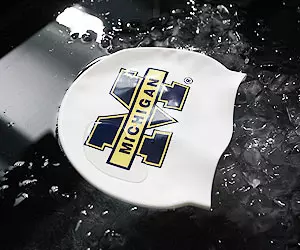
Frozen Wolverines: The Quest Through the Ice Chest
3/22/2008 12:00:00 AM | Women's Swimming & Diving, Features
Michigan is cold. That may be an understatement, but on a campus where there is general celebration when temperatures break 25 degrees, there is a group of Michigan women's swimmers subjecting themselves to the rigors of an ice bath that makes a January walk across the Diag seem like a beach getaway.
Both before and after a long day of class, Michigan swimmers press their bodies to the max, waiting for the day their hard work pays off and they can, as U-M head coach Jim Richardson says, see some justice.
The lengths Michigan swimmers go to achieve that justice would send shivers down the spine of most sane individuals. Not many people would come inside a blustery Michigan afternoon only to submerse themselves in 76-degree water for two hours of workout. That temperature doesn't seem so bad in comparison to the weather outside, but it is only the beginning.
Sports are full of strange rituals. Some claim physical benefits, other psychological, and still others are purely superstitions. To the athletes who finish a long day of workouts with a long soak in 56-degree ice water, it may be a bit of all three.
Ice baths, taken following competition and during rigorous training schedules, have become a mainstay of many swimmers' routine. Walk onto the deck at this year's NCAA Championships in the McCorkle Aquatic Pavilion and you will find a row of therapy tubs lined up along a black curtain wall. These tubs, hidden from general view, are filled by one, two and even three athletes with the look of extreme concentration on their faces.
The tubs, filled with cold water and buckets of ice, are intended to clear lactate that builds up during the intense physical activity of swimming a race, according to Michigan athletic trainer Keenan Robinson. He added that it allows the athlete to recover faster and push her body harder, sooner.
The experience of plunging into an ice bath is a staged one. The first stage as you first dip into the tub is nauseatingly painful as your chest contracts and shortness of breath ensues. After two minutes, the sharp pain starts to dissipate into a dull ache as your extremities begin to numb. Moving from three to six minutes, the process begins to smooth out. If an athlete can contain the chattering teeth through seven minutes, she is truly an ice bath pro. The hot shower that follows returns sensation to the athlete's limbs with a rush that also begins to wash away goosebumps.
There are many swimmers who swear that the effects of this venture outweigh the pain. Fifth-year senior Melissa Jaeger, a four-time honorable mention NCAA All-American, says with a laugh that she likes the pain.
"It is like a personal challenge," Jaeger said. "It requires the mental ability to remain relaxed and calm under the most adverse conditions."
Jaeger endorses the ice bath as a never-fail mental and physical recovery method -- one that has served her well this season. She notes that some people shy away from it but claims they are wimps. An athlete that will do whatever it takes is an excellent example of a Michigan women, and Jaeger is just that.
"I am no wimp!" Jaeger insisted.
The next time you come in from a run down State Street and your legs are burning, consider the readily available solution of taking a dive into a pile of snow. Then be thankful you can take an aspirin and take it easy tomorrow. For the few willing to go to the extreme of submerging into a pool of frigid ice water in pursuit of success, all the respect goes to you.
Better you than me.
Emily Christy is a sophomore swimmer. She was selected as an alternate for the U-M contingent at the 2008 NCAA Championships.








